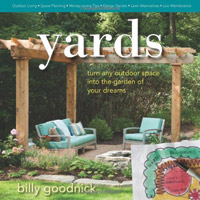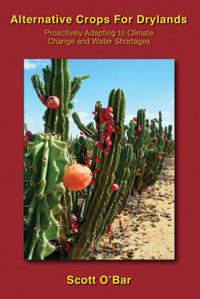How-To Books
New Ways to Look at Your Garden
The debate still rages about books. Will they survive the electronic age? So far, they seem to be holding their own in the how-to world, at least. Two new books are just out that take very different looks at what modern gardens could, and maybe should, be like.
Area garden guru (Garden Wise Guys is just one of his claims to fame) Billy Goodnick has collected his garden-design wisdom in a new book called Yards: Turn Any Outdoor Space into the Garden of Your Dreams (St. Lynn’s Press). Even the title states that this is a purely American perspective; “yards” are not synonymous with “gardens” in the Old World, especially Britain and her former colonies. Goodnick takes a no-nonsense approach to gardens, er, yards. For years, he has taught a popular class through the Continuing Education Division at Santa Barbara City College, and he’s also written many a blog and magazine article about his passion: good design for every garden. This book provides the blueprint for anyone wishing to maximize their gardening enjoyment, enhance the value of their home (and neighborhood), or minimize maintenance and environmental impact through proper planning.

Yards lays out a step-by-step process to analyze what your area already contains, what style of garden fits your particular lifestyle and family makeup, and which elements of garden design, from hardscape (“if it isn’t green, it’s hardscape”) to plant selection, will complete the process of transformation in your particular situation. To quote Goodnick (but not give away the punch line), “A good yard isn’t a product, it’s a process. The good news and bad news is that a garden is never done: Shade happens, gophers git yer gladiolus, kids outgrow swing sets, tastes change.” But when you make it to the end of this book and start putting the key ideas to work for you, I promise you’ll have a yard that will meet your needs for years to come.
Scott O’Bar has tackled a large topic, as well — climate change and how to feed future generations in a warmer, probably drier climate. Alternative Crops for Drylands: Proactively Adapting to Climate Change and Water Shortages (Amaigabe Press) may not be for everyone, but it is surely going to be a valuable resource for anyone joining the corps of farmers, big and small, will be able to feed future generations. Each entry, from “Nitrogen-Fixing Plants and Legumes” to “Palms,” “Cacti and Succulents,” and other “Miscellaneous Edible and Medicinal Plants,” contains extensive information about hardiness and water requirements, as well as uses for the products of the plant. O’Bar has even included a section on potential drawbacks of planting each species.

O’Bar is also an advocate for agricultural diversification. Monocultures, of which most contemporary farms consist, can lead to potential disasters should a crop fail due to weather events or pest outbreaks. O’Bar asserts, “Growing edible plants in harmony with the earth and using natural ecosystems as a design model allows for the sustained presence of ‘food forests’ on this planet. These systems require few additional inputs once established, and may remain in balance for years even without the help of humans. The plants featured in this book should be used to construct artificial ecosystems, which achieve the same balance and permanence as natural ecosystems.”
The book concludes with a series of useful lists of plants that fit particular criteria such as “Minimum Rainfall Requirements,” “Salt-Tolerant Species,” “Shade-Tolerant Species,” and more. A “Resources” guide will point the way to further investigations.
To meet the authors and get a look at (and buy!) the books up close, here are some events at which they will be appearing soon:
• From Deserts to Desserts will feature O’Bar speaking on how to reverse desertification by planting edible forests and highlight some edible, water-wise plant choices for Santa Barbara gardens at the Ayni Gallery (216 State St.) on Monday, April 15, at 7 p.m. Check cropsfordrylands.com for further information.
• Goodnick will be signing books at porch (3823 Santa Claus Ln., Carpinteria) Saturday, April 6, 3:30-5:30 p.m.; the Santa Barbara Botanic Garden (1212 Mission Canyon Rd.) Sunday, April 7, 3-5 p.m.; Chaucer’s Books (3321 State St.) Tuesday, April 9, 7 p.m.; and Baron Brothers Nursery (7568 Santa Rosa Rd., Camarillo) Saturday, April 13, 10 a.m.



